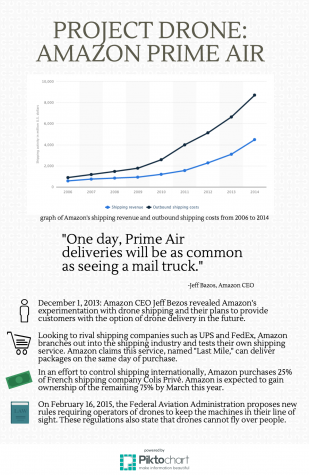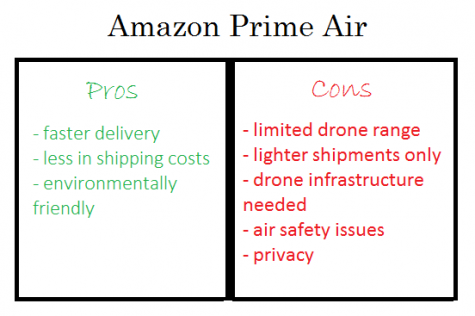Amazon Prime Air drone delivery service raises questions about scale and cost
January 16, 2016

The infographic above depicts Amazon’s rise in shipping and outlines many key issues with the Amazon Prime Air delivery system. Amazon CEO Jeff Bezos hopes to revolutionize the shipping industry through drone delivery.
What started out as an idea may soon become a reality – since Amazon’s announcement of experimentation with drone shipments in December 2013, the company has gained more control over the shipment of their products and improved their drones to fit new Federal Aviation Administration regulations.
Amazon’s drone shipping service, also known as Amazon Prime Air, utilizes Octocopter drones to fly packages of less than five pounds straight to customers’ doorsteps. Advertised to be able to ship products in 30 minutes or less, drones can only deliver to places within a ten-mile radius of a participating Amazon order fulfillment center. Currently, coverage is still limited because there are only 72 centers nationwide, five of which are in California.
Amazon CEO Jeff Bezos revealed the company’s drone shipping project in a 2013 interview with CBS News’ 60 Minutes. Estimating that drone shipments will be a service available to customers in four to five years, Bezos predicts that “one day, Prime Air deliveries will be as common as seeing a mail truck.”
With promises of much faster delivery times, Amazon’s drone shipping may seem to benefit both the company and its customers. However, complicated air traffic patterns, the drone shipment restrictions and service costs prevent drone shipping from being a secure and reliable way to receive products from Amazon. While Amazon’s drone system is still in concept stages, drone delivery still has key problems.
Greater drone usage for shipping services will result in more congested air traffic. Drones will now have to compete for airspace with airplanes and other flying objects, while running the risk of hitting another object while in flight. Drone traffic control towers, launchpads and landing sites will be needed for operators to manage drones safely. The drones themselves have been estimated to cost a hefty $50,000.
In addition, shipments delivered by drone must also weigh less than five pounds and fit within the drone’s cargo box. While 86 percent of Amazon products meet this weight requirement, products that are heavier than five pounds will have to be delivered by land instead.
Finally, Amazon will also have to hire competent drone operators, in addition to managing drone traffic control towers, launchpads and landing sites. The cost of building these structures may result in higher shipping prices for Amazon customers. According to R. John Hansman, Professor of Aeronautics and Astronautics at MIT, “they will have to charge a significant premium for this kind of delivery, so the products would need to be worth a $100 to $200 delivery fee for a five-pound or so package.”

Despite the potential of Amazon’s drone shipments, the company’s current model for the drone delivery system will not meet the needs of customers adequately. The problems of managing air traffic, restrictions placed on drone shipments and the cost of funding are all reasons why Amazon Prime Air may not be a viable shipping method for the future.


















![“[Building nerf blasters] became this outlet of creativity for me that hasn't been matched by anything else. The process [of] making a build complete to your desire is such a painstakingly difficult process, but I've had to learn from [the skills needed from] soldering to proper painting. There's so many different options for everything, if you think about it, it exists. The best part is [that] if it doesn't exist, you can build it yourself," Ishaan Parate said.](https://harkeraquila.com/wp-content/uploads/2022/08/DSC_8149-900x604.jpg)




![“When I came into high school, I was ready to be a follower. But DECA was a game changer for me. It helped me overcome my fear of public speaking, and it's played such a major role in who I've become today. To be able to successfully lead a chapter of 150 students, an officer team and be one of the upperclassmen I once really admired is something I'm [really] proud of,” Anvitha Tummala ('21) said.](https://harkeraquila.com/wp-content/uploads/2021/07/Screen-Shot-2021-07-25-at-9.50.05-AM-900x594.png)







![“I think getting up in the morning and having a sense of purpose [is exciting]. I think without a certain amount of drive, life is kind of obsolete and mundane, and I think having that every single day is what makes each day unique and kind of makes life exciting,” Neymika Jain (12) said.](https://harkeraquila.com/wp-content/uploads/2017/06/Screen-Shot-2017-06-03-at-4.54.16-PM.png)








![“My slogan is ‘slow feet, don’t eat, and I’m hungry.’ You need to run fast to get where you are–you aren't going to get those championships if you aren't fast,” Angel Cervantes (12) said. “I want to do well in school on my tests and in track and win championships for my team. I live by that, [and] I can do that anywhere: in the classroom or on the field.”](https://harkeraquila.com/wp-content/uploads/2018/06/DSC5146-900x601.jpg)
![“[Volleyball has] taught me how to fall correctly, and another thing it taught is that you don’t have to be the best at something to be good at it. If you just hit the ball in a smart way, then it still scores points and you’re good at it. You could be a background player and still make a much bigger impact on the team than you would think,” Anya Gert (’20) said.](https://harkeraquila.com/wp-content/uploads/2020/06/AnnaGert_JinTuan_HoHPhotoEdited-600x900.jpeg)

![“I'm not nearly there yet, but [my confidence has] definitely been getting better since I was pretty shy and timid coming into Harker my freshman year. I know that there's a lot of people that are really confident in what they do, and I really admire them. Everyone's so driven and that has really pushed me to kind of try to find my own place in high school and be more confident,” Alyssa Huang (’20) said.](https://harkeraquila.com/wp-content/uploads/2020/06/AlyssaHuang_EmilyChen_HoHPhoto-900x749.jpeg)









